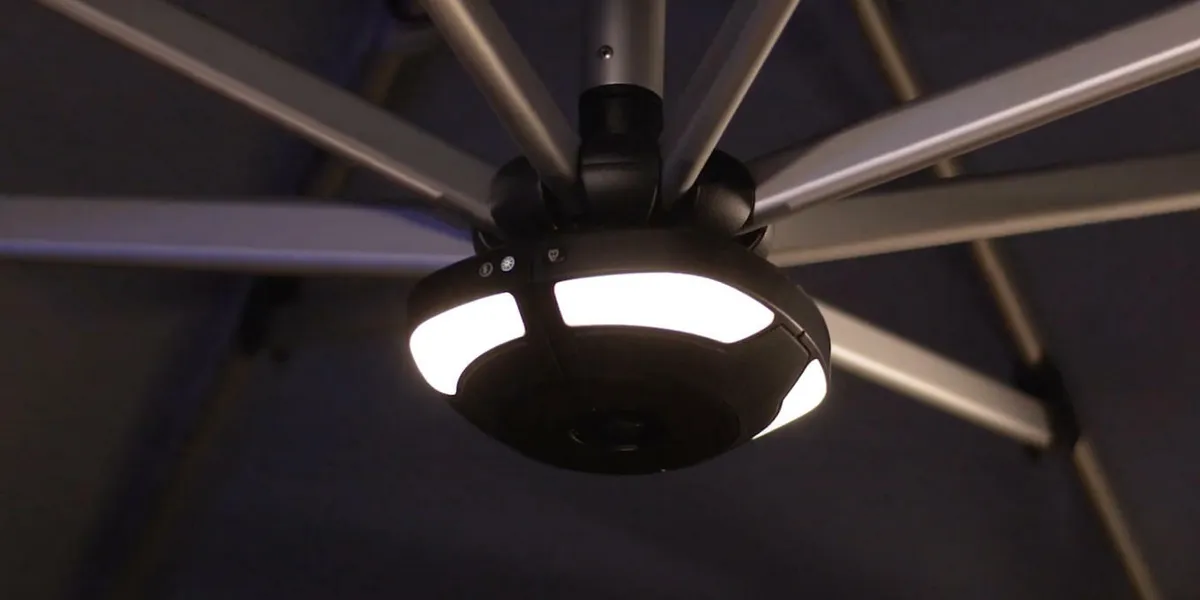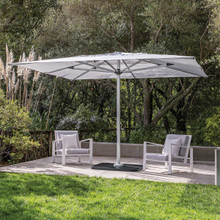Replacement Umbrella Canopy Parts & Accessories

















Patio umbrella replacement canopies & parts
Over time, even the best umbrellas need to have components replaced. After a few seasons, the sun's harsh UV rays and unpredictable weather starts to show. A faded or torn canopy and broken parts can make you think it's time to toss it and buy a new one or fix it. But the cost to repair parasol fabric, frames, tilt mechanisms and other parts can be high. Fortunately, many premium shade manufacturers stock components separately so you don't have to buy a whole new umbrella.
Outdoor umbrella canopies
Replacing an old or damaged canopy offers you an opportunity to infuse fresh vibrant fabric colors into your outdoor space, coordinate with a new palette or upgrade to more durable material options that are weather-resistant. Consider upgrading your lightweight furniture-grade Sunbrella® canvas with heavier weight awning or marine-grade fabric. These fabrics offer better water, wind and UV resistance, have higher tensile strength and hold up better in coastal salt air environments.
Canopy compatibility check
Before purchasing a replacement umbrella canopy, double-check if it fits your existing umbrella frame. Companies update designs over time, which could make a new patio umbrella canopy incompatible with an older model. The same thing goes for older pavilions, cabanas and modern framed canopies. Be sure to measure the dimensions of your existing umbrella canopy and frame radius to ensure you order the correct size.
Additionally, note the rib count, rib specifications and how the canopy attaches to the frame. If you're unsure, give us a call at 888.784.4644 or email details and photos to our sun shade experts. We'll initiate a compatibility check with manufacturers to confirm newer canopies fit or that they still make versions that are compatible with your umbrella model.
Patio umbrella parts
While swapping out fabric is relatively easy and obvious, you can really save money by replacing damaged components too. Modern shades, especially cantilever parasols, have a lot of valuable features. They tilt in many directions and are often foldable and portable. However, that means that they also typically have more small mechanisms and umbrella parts that can break. The good news is that spare poles, frames, cranks, ribs and hub assemblies are often available a la carte and are much less expensive than replacing the whole shade. You may have to review a parts diagram, call customer service or watch DIY YouTube videos to properly install spare parts yourself, but it's worth the time and effort.
Patio umbrella lights
Deck umbrellas are great for shade and UV protection during the day, but when the sun goes down, the party often ends. Outdoor umbrella lights are a great way to illuminate your backyard, deck, swimming pool or outside area so you can enjoy more time with family and friends well into the evening. They're easy to install and may include Bluetooth® speakers.
Here's what you can expect with contemporary outdoor parasol lights:
- Rechargeable batteries - While there are some plug-in models, most versions are powered by removable battery packs that you charge when not in use.
- Long-lasting LED lightbulbs - Modern umbrella lights are equipped with long-lasting energy-efficient LED bulbs usually powered by rechargeable batteries.
- Remote control or app convenience - Operate your lights with a remote control or even a mobile app for ultimate ease of use.
- Customized display - Many lights offer adjustable brightness and even color-changing features to create the perfect atmosphere.
Protective umbrella covers
You invested in quality center pole and offset umbrellas for sunny days, But what about protecting it during rain, snow and off-seasons? Our durable patio umbrella covers are made from weather-resistant synthetic materials and help to keep your replacement umbrella canopy looking great and functioning properly for a long time. They're relatively inexpensive and help you avoid damage costs over time. Also, protective covers are designed to fit your specific umbrella and are easy to use and clean.
Pro tips before you buy a replacement canopy, parts or accessories
- Compatibility - When purchasing replacement parts for garden umbrellas, be sure that they will work with your specific model. Brands update product specifications so new versions may have slight differences in attachment mechanisms and design requirements.
- Size - Many umbrella accessories have very precise measurements that limit the size of the shade, canopy, pole or frame they can work with. Check specification sheets to ensure everything fits properly, including umbrella base tubes.
- Additional Components - Double-check that all required pieces, bolts, screws, etc. are included and identify sources for anything missing.
- Instruction Materials - Review all manufacturer installation guides before attempting to replace umbrella parts or integrate accessories. Improper actions and tools may cause damage to both your umbrella and the new component or waste time. Not following directions may also have warranty implications.
- Power Source - Umbrella lights and speakers are battery-powered, solar-powered or need a hardwire connection to an electrical outlet. Understand the powering method in advance to avoid a surprise if extension cords are needed.
Frequently Asked Questions - Replacement Umbrella Canopy, Accessories & Parts
How do you replace the canopy of an outdoor umbrella?
If you purchased a canopy replacement from the manufacturer or one that's compatible in size and design with your original, changing out the fabric should be relatively easy if you follow the 10-Step process below.
NOTE - If you have a market umbrella that is larger than 10 feet in diameter or you're worried about getting up on a ladder, you might want to lay it on the ground for steps 2-9. Cantilever umbrellas should remain upright during the process unless you have a lot of help since they are heavy and often challenging to mount.
Helpful Tools & Equipment
- Footstool or step ladder
- Screwdriver (manual or electric)
- Allen wrench or hex key
- Needle nose pliers
- Damp rag
- Soft brush
Step 1 - Close the umbrella
When the umbrella is fully open, the canopy is taut and removing it risks damaging the rib assembly or possibly injuring you.
Step 2 - Free the old canopy from the rib tips
Many pool umbrellas have canopies with sewn-in pockets in which the tips of the ribs fit. If that's what yours has, gently pull down on a canopy corner with one hand and guide the rib tip out with the other. Repeat this until all pockets have been emptied (usually 6-8 ribs). High-end and commercial-grade outdoor umbrellas may attach canopies to the rib assembly with screws or hex bolts that pass through metal grommets at the edge of the canopy. In this case, use the appropriately sized manual screwdriver, electric screwdriver bit or Allen Wrench/hex key to remove the bolts. Set them to the side so they don't get lost.
Step 3 - Detach the finial
The finial is a cap at the top of an outdoor umbrella that helps to stabilize the center of the canopy fabric. It may be a simple ball or an elaborate decorative flourish. Depending on the umbrella's height (or yours), you may need a footstool or step ladder to access it. Most can be removed by simply unscrewing it. Set it off to the side with the bolts (if used) so it can be easily accessed later.
Step 4 - Remove the old canopy fabric
Slowly lift the fabric from the top center of the canopy with one hand and gather more with the other until it is completely freed from the rib assembly. If you missed removing or detaching any ribs, you'll quickly discover your omission here. With the removed canopy in hand, carefully step down off the stool or ladder (if used) and set the fabric out of the way.
Step 5 - Check the condition of the canopy framework
Occasionally, individual ribs may get damaged during wind gusts or if the umbrella is opened or closed improperly or while obstructed. Sometimes, the attached fabric itself helps to hide structural damage beneath. Take advantage of the naked umbrella to inspect each rib, connector and hub to ensure that they are in perfect working condition. If anything is broken, you may want to buy a replacement before attaching the new canopy.
Step 6 - Clean the ribs and hubs
Remove any debris that may have accumulated in the framework. There are plenty of moving parts in the hub and rib assemblies where leaves, pine needles and other small particles may have gotten wedged in over time. Needle nose pliers are extremely helpful for removing small bits from tight hard-to-get-at spaces. Once the umbrella frame is free from debris, wipe down everything with a damp rag. This is the perfect time to clean off dirt and grime and make your umbrella look its best. Use soapy water and a soft brush if needed to address stubborn build-up.
Step 7 - Put on the new canopy
Drape the replacement fabric over the umbrella frame and center the hole with the top of the pole or frame. Rotate the canopy to align the corners of the fabric with the ribs.
Step 8 - Reattach the finial
Screw the finial through the hole and into the pole or frame. You might not want to screw it in all the way to give you a little “wiggle room” to adjust the fabric if the corners get slightly misaligned.
Step 9 - Secure the new canopy to the rib tips
Reverse the process you used in Step 2 to fit the fabric to the rib assembly. It may be easier if you slightly open the umbrella so that you don't accidentally miss a rib and attach the fabric incorrectly. Also, be careful not to tighten any screws or hex bolts too tightly to avoid stripping the holes (especially if the ribs are wood or fiberglass). Work your way around until all corners of the canopy are attached. If you left the finial a little loose, tighten it down at this point.
Step 10 - Open the sun umbrella
Slowly open the umbrella and monitor everything to make sure that it's opening evenly and that the ribs are properly positioned. New canopies tend to be slightly smaller than the old stretched-out ones they're replacing, so the tension is going to be stronger initially. Don't force the canopy open quickly and risk bending ribs. Go slowly to allow the rib tips to settle in their pockets or adjust to their new fasteners and the increased tension safely.
How do you attach patio umbrella lights?
Umbrella lights are typically attached in one of two ways, depending on the product design.
- Ring Umbrella Lights - These round clasp-like LED umbrella accessories open up and close around the central pole of market umbrellas or lower hub extension posts of some cantilever models. Most products automatically adjust to the diameter but may not be compatible with wider poles. You can place them at any height you want along the pole. They should be removed before closing the canopy to prevent damage.
- String Umbrella Lights - These resemble holiday lights and may be strung along individual ribs and secured with cable ties or hung from the edge of canopies by clips. If the LED bulbs dangle like icicles or have excess wiring, be careful when opening and closing to avoid tangles.